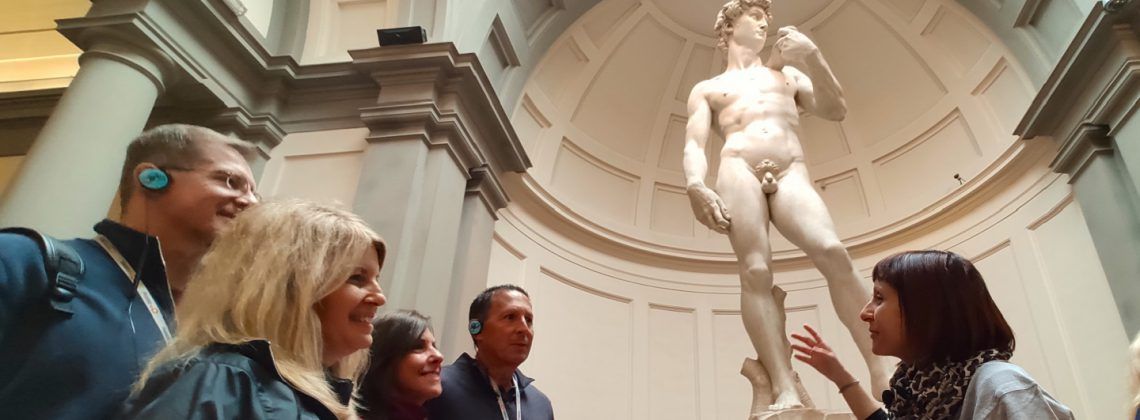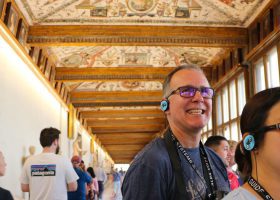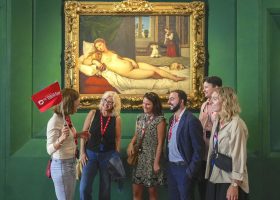The Accademia is the second most visited museum in Florence, and the main attraction, David by Michelangelo, is considered one of the most important works of art ever created. You may be wondering, what else is there to see at the Accademia? How about a $16 million dollar violin? Here’s a list of the top things to see at the Accademia in Florence.
Pro Tip: Planning your visit to the Accademia in Florence? Bookmark this post in your browser so you can easily find it when you need it. Check out our comprehensive Accademia Gallery guide for more planning resources, our best Florence tours with the Accademia for a memorable trip, and how to see Florence in a day (with itinerary).
Top 6 Things To See in the Accademia Gallery
Admittedly, the Accademia Gallery is a very small museum, and the main reason to go is Michelangelo’s David. For this reason, many people head into the gallery, take a look at David, and leave.
If you’re going to spend the money on admission, you may as well poke around and see what else there is. In fact, there are many other noteworthy works of art inside.
We reached out to our knowledgeable guides, who know everything there is to know about this quaint museum, to put together this list of the top things to see at Accademia.
Not ready to book a tour? Check out our article on the best Florence tours to take and why.
6. Hall Of Colossus

Hall of Colossus is the most significant collection of relevant artwork in Accademia, not including David. The centerpiece is Giambologna’s Rape of the Sabines. An often portrayed and incredibly significant historical scene from antiquity. It is a wonderfully baroque statue ripe with passion.
Rape of the Sabines:
The Rape of the Sabines Women, also known as the Abduction of the Sabine Women, is as heavily debated as it is depicted in art. The most commonly accepted version is that the Roman population was mostly formed by male outcasts and wanderers and happened to be majority male. They needed women to expand their population.
Romulus is said to have first attempted to form treaties with other nearby tribes to increase their female population, but it was not met openly. This forced Romulus to take more drastic action. He basically decided to throw a party or festival and invite neighbors. Apparently, the Sabines really enjoyed a good festival, and the entire population attended. This was good for the Romans as they were planning to abduct the Sabine women.
At some point, Romulus stood up and gave the signal, and the Romans moved in on the Sabine women. They abducted all the virgins with the exception of one married woman, Hersilia, which is a whole other story. This made the Sabine men unhappy—as you can imagine, all their daughters had been taken. War erupted lasting long enough for the Sabine women to accept their Roman husbands.
Legend has it that at the beginning of the big battle between the Sabines and Romans, the Sabine women stood in the middle between their husbands and kin, begging for the bloodshed to end. And they were successful. Treaties were signed, and they lived in peace for a while.
The Rape of the Sabine Women is the beginning of Western European civilization, which makes it an extremely important event. This is why it is so often painted. It also opens a primordial debate: how do our beginnings affect who we are today?
Giambologna’s statue, Rape of the Sabines Women, is the most widely celebrated depiction of the event. There are hundreds of paintings and sculptures depicting the event, but Giambologna’s seems to come out on top. Due to its significance, the original version is in the Loggia dei Lanzi, a covered area with many sculptures in Piazza della Signoria. What you see in the Hall of Colossus is a plaster model used in construction.
Left Wall Paintings:
You’ll see Trinity by Alesso Baldovinetti depicts the holy trinity between God, Jesus, and the Holy Spirit, the Trebbio Altarpiece by Botticelli commissioned by Lorenzo di Pierfrancesco Medici, and St. Stephen, St. James, and St. Peter by Domenico Ghirlandaio, which is considered the greatest painting of the six on the left wall.
Right Wall Paintings:
On the right wall, you’ll see Assumption of the Virgin by Perugino, which is a panel painting featured in the center with a rounded top and showing the Virgin Mary ascending into heaven; Resurrection by Raffaellino del Garbo, depicting Jesus leaving the tomb; and Deposition by Filippino Lippi, a brilliant work showing Christ being removed from the cross after his death.
5. Hall Of Prisoners
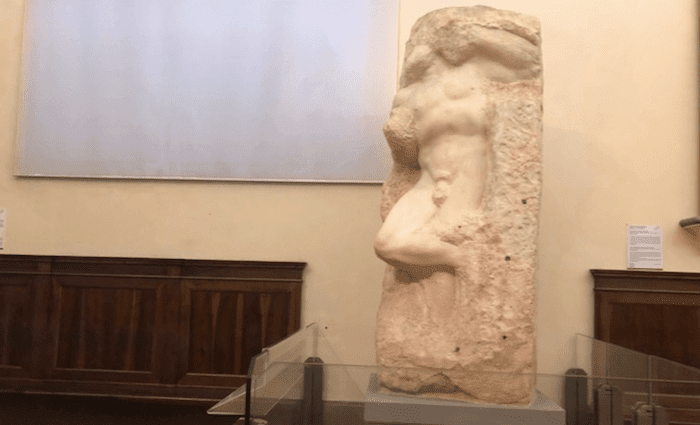
Michelangelo was quite the artist and took his craft very seriously, which is why the Hall of Prisoners is so important. Nobody would labor over a statue for three years without passion. As you may have read, he didn’t feel he was the creator of this artwork. He felt more like the liberator, and technically he’s correct. The statues already exist in the block of marble, he’s simply the guy that gets them out. The hallway leading to his masterpiece is lined with his failures—unfinished statues that didn’t make it out.
Referring to them as prisoners is both literal and figurative. They’re trapped in marble, but they were actually intended to be statues of prisoners holding up columns for the tomb of Pope Julius II. The tomb, commissioned by the pope to Michelangelo, was intended to showcase 40 statues in a massive structure built for St. Peter’s Basilica. Unfortunately, there were some budget cuts. Then, the pope died, which led to the tomb being placed on the back burner.
It was finally finished by Michelangelo in 1545 but placed in St. Peter in Chains church, which is near the Colosseum. It’s much smaller than intended, but the centerpiece, Moses, is one of Michelangelo’s crowning achievements. Pope Julius II was never laid to rest inside either—he is buried inside the Basilica of St. Peter.
4. Gipsoteca Bartolini
Just around the corner from the Accademia is Florence’s very own art academy. Much of the reason why the Accademia was opened in its rather obscure location was to be close to the university where young artists trained to become masters. This is also part of the reason why the Gispoteca Bartolini is so interesting.
Lorenzo Bartolini was a 19th-century sculptor who became quite famous in Florence. He sculpted for prominent Italians, Russians, English, and basically, anyone who could afford his work. The Gipsoteca does not show his finished works; instead, you’ll find the plaster or clay models he used to create these works.
Bartolini was also a professor at the art academy, and the Gipsoteca is a recreation of his workshop. You’ll see hundreds of busts along with a few statues and paintings by him and his student. 19th-century nobility, along with other masters like Brunelleschi, are featured. It’s cool to walk through this room and understand the origins of sculpting.
Not ready to book a tour? Check out our article on the best Florence tours to take and why.
3. Florentine Gothic Art
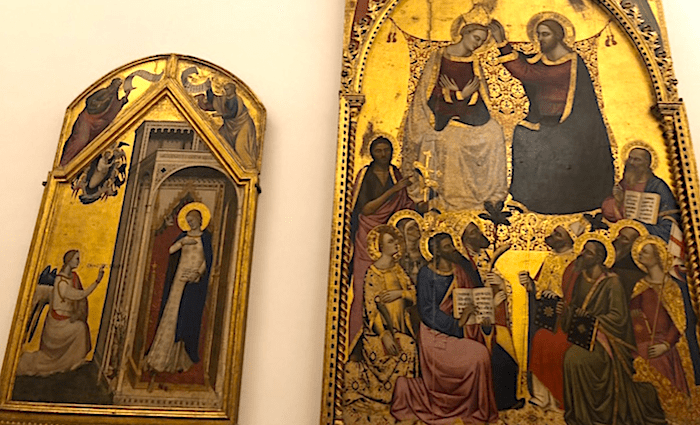
The Florentine Gothic Gallery is spread out over three rooms and dedicated to the 13th and 14th centuries. It houses many Gothic altarpieces adorned with gold, so they will be brilliant and over the top.
You’ll usually hear the name Gothic or Byzantine referring to artwork produced during the Middle Ages. This is because the style in Italy was copied from the Byzantine Empire, which was still extremely powerful and influential during the medieval period. If this period of artwork interests you, then there are a few patterns you’ll notice.
Patterns in Gothic Art:
Firstly all of the artwork is religious. The Middle Ages are also known as the “Age of Faith,” and nowhere is that more obvious than in the artwork of the period. The paintings were almost always commissioned for a church and usually for over the altar. Unlike the Renaissance, the goal was not an ideal beauty but an overwhelming display of piety.
Secondly, the figures are completely off. What I mean is the bodies do not reflect what real people looked like neither in terms of dimension nor fullness of features. You’ll notice that they are always two-dimensional.
Thirdly, there is no perspective. This means that the paintings rarely show any depth at all. Compared to Renaissance paintings, where there are multiple levels, here there’s only one level, and everyone fits on that same level overlapping each other.
Finally, the halos above their heads look like gold plates. Due to the fact that they couldn’t (or wouldn’t) use depth in the painting, they would show someone was holy with their idea of a halo—a golden plate. Again, once we get to the Renaissance, this disappears, and the halo as we know it today appears.
As a lover of Renaissance art, I don’t value Gothic art as much as I should. That said, the room deserves a walkthrough. Keep an eye out for Bonaguida’s Tree of Life panel, showing Christ on the crucifix, which doubles as the Tree of life. You’ll also find a detached fresco by Giotto di Bordone, which deserves a look.
It’s unlikely you’ll recognize many names in these three rooms, but it is important to see how artwork changed in drastic ways from the 14th into the 15th century.
2. Museum or Hall Of Musical Instruments
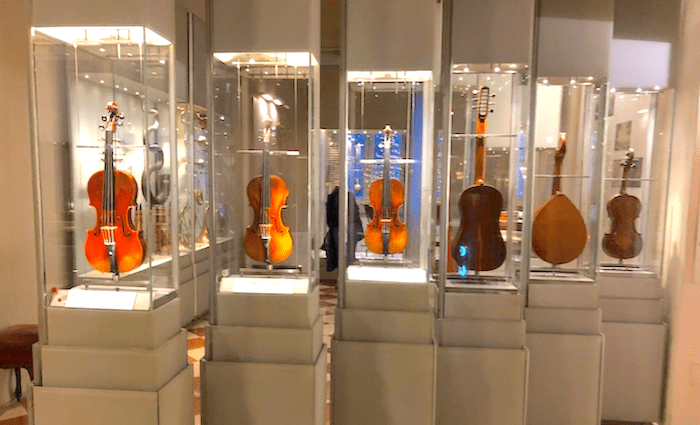
Did you play the violin growing up? If so, the Luigi Cherubini Hall of Musical Instruments in the Accademia may be a nice stop beyond the David statue. In the 17th century, there lived a man by the name of Antonio Stradivari, who produced unmatched musical instruments for centuries.
His instruments were so amazing that his following became an unmatched legacy. Today, the mechanical honing of instruments has eventually led to better sound projection, but Stradivarius instruments have exploded in value. Today, a Stradivarius viola can sell for $16 million dollars.
The Museum of Musical Instruments contains three Stradivarius, including a viola tenor and a cello from the Medicean collection of instruments—their coat of arms decorates both instruments. The viola is reportedly unchanged from the day it was first played, which means it may be the most expensive instrument on the planet.
You’ll also find a room dedicated to the invention of the piano, which was invented for the Medici in 1720. It was invented in 1720 by Bartolomeo Cristofori, evolving from the earlier harpsichord.
All in all, you’ll be able to come up close and personal with not only some of the most expensive instruments in history but many of the same ones that would have produced beautiful music for the Medici.
1. Michelangelo’s David (The Tribune)
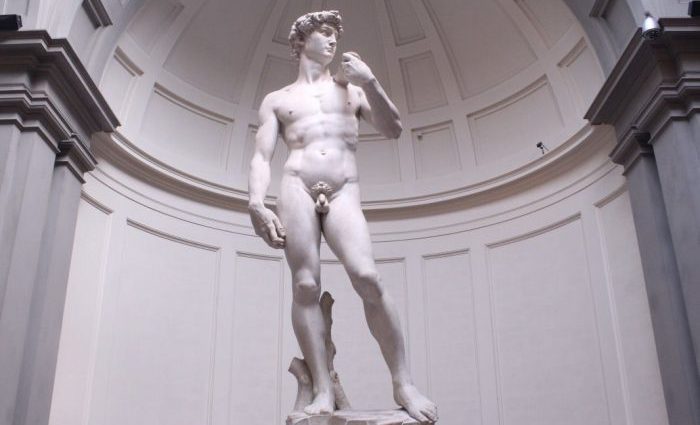
History and religion are bound together and forced apart all at the same time. This means that much of our account of history, especially B.C. history, comes from religious books. Specifically, it comes from the Bible. At the same time, we must work to separate a historical account, the existence of figures such as David or Jesus as King and rebel, from their religious account, favored by God to be King and son of God.
David vs Goliath:
The story of David, true or not, is one of the greatest and most widely referenced stories in ancient literature. This is likely due to Goliath’s size compared to David. Imagine a gigantic man who may have reached 6 feet 9 inches in a time when males averaged 5 feet and 6 inches.
Goliath was so much larger than everyone else that, according to the ancient text of Saul, he came out daily for 40 days, morning and evening, to challenge the Israelites. Not to all-out war, but single combat, which was a way to settle a dispute with less bloodshed. Eventually, one champion from each side would fight to the death, and the victor’s army would win.
Saul was the King of the Israelites at the time and should have fought Goliath, but didn’t. He feared Goliath. At a time when religion and the will of God (or gods) dictated so much, Saul’s fears brought despair to his soldiers and people. David, a shepherd, finally accepted the challenge, and Saul reluctantly agreed. He offered David his armor, but David declined. Instead, David brought his staff, sling, and five stones.
David was a farmer and sheep breeder who likely had to protect his crops from small animals, such as rabbits, to survive. He may also have had some run-ins with wolves preying on his sheep. In such cases, the sling was the preferred weapon, and David would have practiced religiously to ensure he could protect his livelihood.
David used his sling to defeat Goliath. One of his fives stones hit Goliath squarely on the forehead, knocking him straight to the ground. David then cut off Goliath’s head, and the battle was over. Michelangelo’s David portrays David at the moment after his victory when he felt larger than life.
David would take the kingship from Saul soon after, stating, “When a lion or bear came and attacked his father’s (God) sheep (people), he battled against it and killed it.”
The Sculpture Described:
What is so incredibly amazing about this sculpture is how life-like it is. In fact, nothing ever came close to it in the past and arguably ever again. It’s down to the painstaking detail that you’ll see when visiting David. Michelangelo’s depiction of muscle mass, the circulatory system, and human-like features leave you in awe. The structure of his face and the eyes are so detailed that close-up images of them look real.
Michelangelo used a block of marble that Antonio Rossellino worked on some 25 years earlier but discarded, citing the marble was of poor quality, in stepped Michelangelo, who took over the project in 1501 and took it very seriously. In fact, there is a quote where Michelangelo describes his work (which has likely “evolved” over the years). He basically says that his work is not a matter of genius, he simply removes all the material that is not David, as the statue is already locked inside.
Symbolism:
David holds a sling in his left hand and draped it over his shoulder. This is a detail Michelangelo needed to include to identify the statue as David, but it also may be a structural element. In his right hand, he holds an object, which is likely a stone—he was carrying five going into battle. David’s body is more a reflection of his confidence after winning the battle against Goliath. You’ll see that he exudes confidence in his eyes and form.
For all of the reasons above, David is the main attraction of the gallery and, without argument, the most sought-after sculpture in Florence. Copies of David are all over Florence. Michelangelo “freed” David from his marble prison in three years—a very short amount of time for a statue that was immediately greeted as the greatest statue Florence had seen. It was brought to Piazza della Signoria, where it found its home for hundreds of years until 1873, when it was placed in the Accademia Gallery, and the original was replaced by a copy.
Not ready to book a tour? Check out our Accademia and David Guide for more resources.
Accademia Gallery Tickets
For more detailed information about entering and reserving tickets for the Accademia, read our article on everything you need to know about how to visit the Accademia Gallery.
Short on time? Opt for our express Accademia guided tour, designed to efficiently guide you through all the highlights.
Hours: Tuesday – Sunday, 9 am to 6:15 pm (closed Mondays)
Admission: €8 per adult | Free for under 18 year olds
Address: Via Ricasoli 58/60
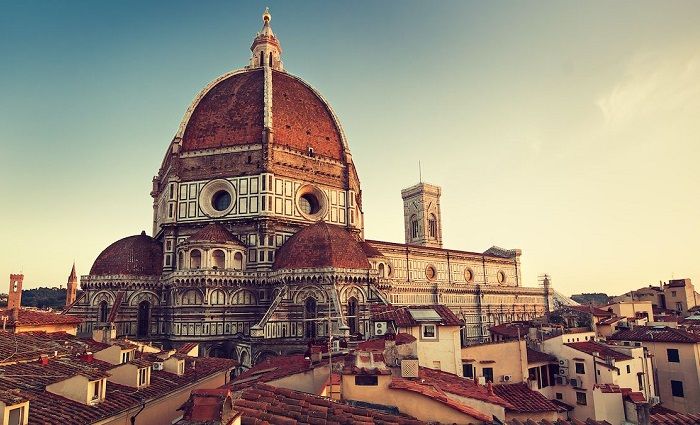
Where To Stay in Florence
Florence has a small historical center packed with iconic landmarks to explore. Plan where to stay in the best neighborhoods in this beautiful city.
